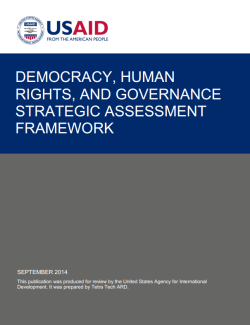The Democracy, Human Rights, and Governance Strategic Assessment Framework provides a structure for conducting a political analysis of a country; develops a strategy to advance democracy, human rights, and governance (DRG); and helps inform integrated development approaches. At its core, this assessment is a political economy analysis (PEA)1 of the DRG sector—how and why is political power acquired, maintained, exercised, and contested? Who benefits? Who does not? Can the U.S Government play a role in trying to change the power dynamics? If yes, how? Most importantly, how can the advocates for democracy, human rights, and good governance achieve greater success confronting the key challenges in their country with assistance from the United States Agency for International Development (USAID)? Honing in on the key challenges and opportunities of democracy, human rights, and governance provides a realistic analysis of actors, formal and informal institutions, opportunities for reform, and USAID’s operational environment. This strategic assessment framework (SAF) will guide resources to the DRG areas where they will have the greatest impact, thereby increasing the effectiveness and sustainability of DRG programs. This framework also will guide USAID Missions, which are ultimately responsible for developing and submitting strategic plans for program funds over which they have responsibility and authority. The document may also be useful to other parts of the U.S. Government, including U.S. embassies, the State Department, and the National Security Staff, as well as to other donors, although it primarily focuses on USAID policies and procedures.
The framework is divided into four parts to assist practitioners as they think through the main DRG challenges in a country and how to address them:
- An analysis of the challenges relating to democracy, human rights, and governance in a country [Step 1];
- A political economy analysis of actors and institutions that are likely to support or resist democratic reforms, protection and promotion of human rights, and improvements in governance [Step 2];
- Consideration of the U.S. Government’s and USAID’s interests and resources, as well as their comparative advantage vis-à-vis other stakeholders and donors [Step 3]; and
- Strategic and programmatic recommendations [Step 4].

